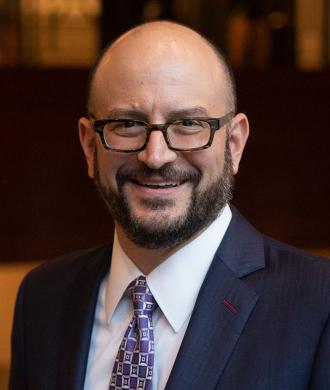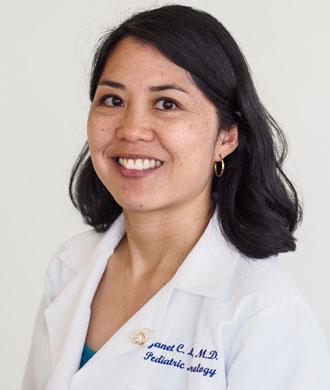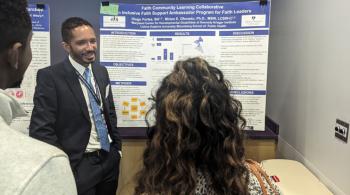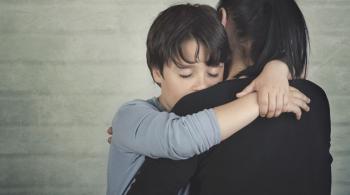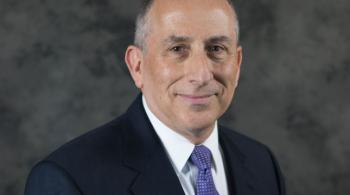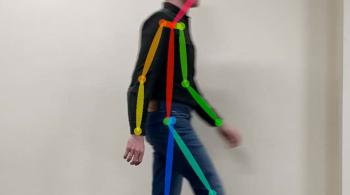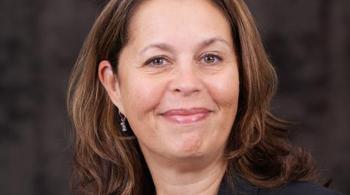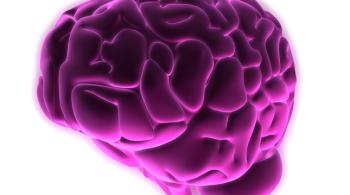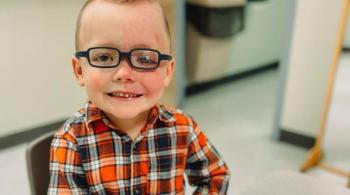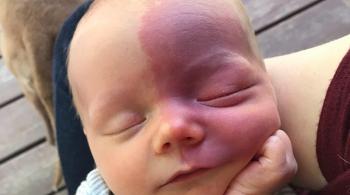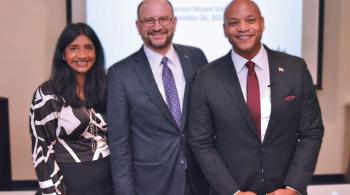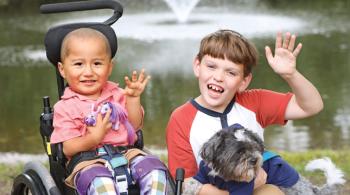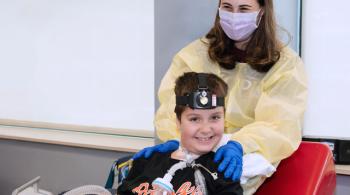On this month’s episode Kennedy Krieger president and CEO, Dr. Brad Schlaggar is joined by Dr. Janet Lam, a pediatric neurologist and an expert in sleep medicine and the director of the Sleep Disorders Clinic and Laboratory at Kennedy Krieger. The two will delve into sleep disorders in children, especially for those with neurodevelopmental conditions.
Resources
Learn More About Our Featured Speakers
Learn More About Our Featured Speakers
View Episode Transcription
Dr. Brad Schlaggar (BS): Welcome to Your Child's Brain. A podcast series produced by Kennedy Krieger Institute with assistance from WYPR, from Dr. Brad Schlaggar, President, and CEO of Kennedy Krieger Institute. Sleep is an essential yet poorly understood and long-underappreciated function of the human brain that's across our lifespan. Lately though, our insights into the role of sleep and health and disease have increased. For example, we now have a deeper understanding of how sleep contributes to consolidating what we learn into lasting memories. In recent years, a good deal of attention has been focused on the importance of sleep for the healthy aging brain and the potential link between poor sleep and neurodegenerative diseases like Alzheimer's disease. But sleep is also a key contributor to healthy brain development for children with and without neurodevelopmental issues. For anyone, poor sleep can make it somewhat more difficult to have sustained attention, clear thinking, effective mood regulation, and so on the following day. But for those with ADHD, for example, poor sleep can significantly exacerbate inattention and impulsivity. Similarly, for individuals with conditions like epilepsy or migraine, as well as others, poor sleep can trigger real clinical worsening. In addition, those who have intellectual and developmental disabilities experience sleep problems at much higher rates than the general population does. In this month's episode, we're going to dive deep into sleep disorders and children, especially those with no developmental conditions. This conversation is timely, as March 10th through 16th this year is Sleep Awareness Week for the National Sleep Foundation. Now it's my pleasure to welcome to the podcast my exceptional colleague from Kennedy Krieger Institute, Dr. Janet Lam, an expert in sleep medicine. Dr. Lam, a pediatric neurologist, is the Director of the Sleep Disorders Clinic and Laboratory at Kennedy Krieger Institute. She's also an assistant Professor of Neurology at the Johns Hopkins University School of Medicine. So welcome Janet. Janet, let's start by talking about sleep per se. Sleep in and of itself is complicated. Multiple stages of sleep, changes over the course of development. Can you take us through a basic description of the general properties of sleep, especially in children?
Dr. Janet Lam (JL): The dynamic nature of sleep is really fascinating and actually correlates with development. In the beginning, we've got newborn sleep, and it's split into 50% active sleep, 50% quiet sleep. Just to explain that, quiet sleep we've got really regular breathing, very little in the way of movement, but then by six to nine weeks of age, this quiet sleep becomes what we know is non-REM sleep, and then that's differentiated into Stages 1 and 2 which is lighter sleep, and then Stage 3 which is slow wave sleep. Active sleep on the other hand, is characterized by irregular breathing, loss of muscle tone, rapid eye movements. You can also see sucking movements and even muscle twitches, and this matures into what we know as RAM sleep. By the age of four months, infants are developing into the four stages of sleep that we label as N1, N2, N3, and then RAM sleep. The amount of slow-wave sleep peaks in early childhood but then drops during adolescence. Then it just continues to decrease through adulthood.
BS: What do we mean when we talk about sleep disorders in children? It's a broad category. What does it really get at?
JL: I like to categorize sleep into five main categories. One, sleep-disordered breathing, which is sleep apnea, either obstructive sleep apnea or central sleep apnea. Two, insomnias, so that is difficulty falling asleep or difficulty staying asleep. Third, parasomnias and this is otherwise known as abnormal behaviors during sleep. Sleepwalking, sleep talking, night tears, all fall into this category. Fourthly, movement disorders during sleep. We've probably heard of restless sleep disorder, periodic limb movements during sleep. All of those follow under movements that occur and can disrupt sleep. Then lastly, hypersomnia, so excessive daytime sleepiness in disorders such as narcolepsy. That's how I categorize different sleep disorders because there are just so many sleep disorders out there.
BS: How common is it for a child to have a sleep disorder, and what are the most common and the most common in childhood?
JL: I think prevalence rates vary a lot in the literature. Anywhere between 20-50 to even 85% of children may have a sleep disorder. We believe that a lot of children are undiagnosed and that the problem is really under-recognized. I would say the most common sleep disorder in children is parasomnia, so night terrors, difficulty staying asleep, insomnia would be probably secondary. Then restless sleep, we all know parents complain that kids are moving around all over the place in bed, and they can't sleep with them. Snoring is also a huge concern, and while snoring may be quite prevalent, up to 25% of kids have snoring. Only about 1-3% actually get diagnosed with sleep apnea.
BS: You mentioned that the rates of sleep disorders vary in the literature. Why do you think that is? Is it because we're not asking the question sufficiently, we're not studying? What are the reasons why there's such variability in the reporting of sleep disorders?
JL: It's probably two-fold. I mean, I think as clinicians, we're probably not asking as much as we should. And I think secondarily, parents aren't bringing it to the doctor's attention, but they're discussing it amongst themselves. We'll see it on social media, my kids not sleeping, what should I do? Trying to get parent advice from other parents instead of going to their doctor.
BS: That's a great segue to the next question to get at. We know that the rate of sleep disorders is higher in children with intellectual and developmental disabilities. Why do children with intellectual developmental disabilities have more sleep disorders? How does it affect their outcomes, and what are some of the approaches to dealing with it?
JL: There's lots of reasons that children with developmental disabilities have more sleep problems compared to their typically developing peers. I would start with by saying a lot of them have underlying cranial facial abnormalities such as a large tongue or a very small jaw, as well as having low tone of their extremities, which also translates to low tone of the airway. These factors put them at more risk for having sleep apnea. Children with disabilities often have a lot of behavioral problems that interferes with their ability to transition from being in the awake state to being sleepy so that they can more easily drift off to sleep. There's also a lot of other comorbid problems that they deal with, such as spasticity, having increased tone, related to pain, seizures, all those things can disrupt sleep and make it harder for them to sleep. Then when we look at children on the spectrum, if they have autism, that they actually have lower levels of melatonin, which makes it harder for them to fall asleep, and why melatonin is often a recommended supplement for them. Then, if you have children who have visual impairment or blindness, they're not getting that light input that they need to develop a good circadian rhythm.
BS: Maybe you can tell us a story about a patient that you've seen. How you discerned their sleep issue, how it was related to their developmental issue and potential approaches to intervening. Tell us a story about a patient that you've encountered.
JL: I would say what's interesting is, I've seen lots of patients who have ADHD, for example, diagnosed with ADHD, even on medication, for example, but sent to the sleep clinic just in case or maybe the parent realized that they probably aren't sleeping enough because the parent isn't getting enough sleep. When we take a thorough history, look over things, we realize that the child isn't sleeping well either because of factors like sleep disordered breathing, or just having a really difficult time settling and falling asleep at night, and therefore not getting good adequate sleep. As a result during the day being inattentive, looking hyperactive, but actually being sleep deprived. When we work with families like this and work to improve sleep, work to improve their bedtime routine, to increase sleep, work on some of these disruptive behaviors at night and the child gets more sleep. They actually don't meet criteria for ADHD. Then secondarily, sometimes these kids are very restless at night and it's just assumed that it's because they have ADHD, wherein if we look at restless sleep and ask about questions related to leg movements, leg discomfort, we find that they actually have iron deficiency, which has a direct correlation with restless sleep. Treating with iron you can significantly improve sleep, reduce sleep disruption, and enable kids to pay attention better at school, be more alert and progress in the learning environment.
BS: It's such a great point. It's easy to imagine how a child with ADHD, for example, might have medication adjustments being made because they're inattentive, impulsive, hyperactive during the day. But if it turns out that addressing their sleep issue alleviates the worsening the following day, they might even be able to come off the medicines that they're on or take fewer medications. The importance of getting at sleep in the history for really all of our patients, especially those that have some neurodevelopmental issue, it's paramount. When should a parent start to be concerned whether your child does or does not have a neurodevelopmental issue? When should a parent start thinking about getting a referral? What symptoms are really indicators of significant sleep problems?
JL: I usually tell parents that they ought to be concerned if their child is falling asleep during school and thereby falling behind in school. I think that's a pure indicator that sleep is not adequate if they're falling asleep in the wrong places. Specific symptoms that I usually ask about or look into would be loud snoring, choking, or gasping for air. Sometimes that's alarming enough for parents that they'll bring a child to the clinic for that. Children who nap during the day who are over the age of six, especially if they grew out of naps and all of a sudden are back to napping, that might be an indication that they're not sleeping well at night. Like I mentioned before, hyperactivity or inattentiveness, sometimes it's an indication that sleep is not going well. Unlike adults who when we're tired, we're sluggish, children are actually more hyperactive when they're tired. Sometimes it's hard to realize that that's related to a sleep disorder. If you notice that the child is sleeping a lot more on weekends, they are probably compensating for inadequate sleep during the school nights. Lastly, if they're very irritable, if there's more behavioral issues, temper tantrums, mood swings that seem out of the blue, sometimes those are indications of inadequate sleep or sleep disorder.
BS: What are some of the tools that you have, besides taking an excellent history and physical examination, what are some of the tools that you have as a sleep medicine expert to help diagnose sleep disorders?
JL: I would say there's probably two main tools that we use through the sleep center. The first are sleep studies, especially for looking at sleep apnea, leg movements or we're trying to understand why a child who is otherwise sleeping a good amount of time and getting a good sleep opportunity is still tired during the day and doesn't feel refreshed in the morning. That's like one night in the sleep lab to look at a number of measures with breathing oxygenation, CO_2, getting a really good look at sleep quality in the lab. The other tool that we use is called actigraphy. It's like a fancy Fitbit watch, but it's research grade. That enables us to get objective measurements in the home environment over a longer period of time, so up to two weeks. The benefit there is we aren't seeing what we call first night effects, so being in the lab, being in an unusual environment. We're actually see what potentially is going on at home to really be able to assess, when is this child actually falling asleep, how much sleep are they getting, how much are they waking? It really helps us guide recommendations for where we need to target interventions for sleep.
BS: The first night effect, it's an interesting point. It's somebody that has problems with sleep, may have a worsening of the problems that they're in an unfamiliar environment as well. The ability to make measurements in the home environment, I could see how that would be very valuable data. Now you get the data, whether it's from the sleep lab directly or the actigraphy measures. How do you then go on to come up with a treatment approach, whether it's medications, behavioral techniques, or both?
JL: When we get a sleep study back, we're mainly assessing for sleep apnea, sleep disordered breathing. If it is positive for that, one of the first lines of treatment in children, which is different than adults, is to look at tonsils and adenoids, to get them removed if they are causing sleep disordered breathing. A referral to ENT is usually one of the first things that we do if a sleep study is abnormal. If we find that there's lots of leg movements, and especially if we notice that those leg movements are causing wakings, then we'll check iron to see if low iron is actually responsible for these leg movements. Aside from that, like when we do the sleep study, and that's normal, we may or may not do actigraphy. When we do actigraphy, I think we're looking more at insomnia, or trying to figure out like, how much sleep a child is getting. If we find that it isn't adequate, we talk to parents, educate them on how much sleep a child is expected to get. We always start with behavioral interventions to try to increase the amount of sleep a child is getting, to improve that bedtime routine, create more calming environment that's consistent. We often recommend things like having a consistent wake time and bedtime even on weekdays and weekends, which isn't popular with kids but necessary when you have a sleep disorder. Sometimes when we recommend all these things and sleep just isn't getting better, we do have to prescribe medications. But it's usually our second line of treatment for kids. But sometimes some kids have such significant behavioral issues or they're just not tired at bedtime, that using a sleep aid can enable families to better apply the behavioral strategies and recommendations that we're making.
BS: Janet, you mentioned a couple of times sleep apnea, and I think we talked about tonsils and adenoids and low airway tone. That's an obstructive sleep apnea. There's also central. Let's define apnea more specifically and talk about how you could have it both from the periphery of your obstruction as well as a brain based reason for apnea.
JL: There are two types of sleep apnea. There is obstructive sleep apnea. As the word implies, something is obstructing the airway. That could be large tonsil and adenoids. It could be extra tissue in the airway. It could also be a floppy airway that is very collapsible. The other type of sleep apnea is central sleep apnea. When we're talking about that, it is lack of respiratory effort or breathing effort. The respiratory center is in our brain stem, so it's in our brain, and that actually controls our drive to sleep at night. If there's anything that might have caused trauma, if there's any abnormalities of the brain stem, then sometimes that results in seeing central sleep apneas. Another cause of central sleep apnea, more in the adults though, is heart disease. Sometimes if we see a lot of sleep apnea, either by frequency or prolonged periods where there isn't a breath being taken, we might recommend an MRI scan to look at the brain stem and make sure there aren't any abnormalities responsible for that. I should mention the treatment for sleep apnea aside from getting tonsils and adenoids out if that is not an option or that is not the reason because there's nothing surgical that could be done, CPAP is the next line of therapy for children, but the first line in adults.
BS: Children with neurodevelopmental issues are at greater risk for both the obstructive sleep apnea as well as the central. We've talked a bit about, you're addressing some of the behavioral approaches. There's this term sleep hygiene that's used quite a bit. What do we mean by sleep hygiene and what advice do you give parents to help improve their child's hygiene?
JL: Good sleep hygiene, just like dental hygiene, is about developing these good habits to facilitate sleep. One of the first things we might talk about is not a popular thing by kids or some even with parents, but trying to limit electronics, I try to give them two hours before bedtime to have a specific time to shut off electronics. The reason why electronics are an issue is because they're very stimulating. They interfere with bedtime because who wants to quit playing their favorite game? They also emit very bright light that tends to interfere with our own body's endogenous production of melatonin, which tends to delay bedtime. A second thing I might talk about is just being consistent about the bedtime and waketime. Our brains are very boring. They like the same bedtime, the same wake time. That's why on weekends when we want to sleep in, our body still wakes up at the same time and we want that to work in our favor for kids who have a sleep problem. Creating a calming bedtime and routine is just super important because it's really hard to be go, go, go, and then think that a child is just going to lay down and fall asleep. We really need to create some calming, relaxing activities around sleep, so that process goes much more smoother. We talk about the sleep environment, trying to limit bright light, trying to have some noise or music to distract and create this soothing calming environment. Anything that is currently on or off during bedtime needs to remain that way during the night because that also can create a disruption. If you fell asleep with nice music that sounded like the rain, and you woke up and it was completely silent, that can actually disrupt sleep. We try to encourage families to have something that plays continuously through the night. Then lastly, talking about independent sleep or co-sleeping. Independent sleep would be, a child is able to fall asleep more independently. We find that if they're successful at that, then usually in the middle of the night, they can use those same strategies to be able to fall back asleep without needing parental intervention.
BS: Why is it that children with neurodevelopmental disorders are at greater risk for having sleep disorders? What's the argument for why there's that close association?
JL: I think because children with disabilities have so many other comorbid issues that interfere with sleep. It could be that they have craniofacial abnormalities. For example, a large tongue or a small jaw predispose them to having a more collapsible airway or something that blocks the airway, resulting in sleep apnea. Some of the behaviors can interfere with that transition to sleep. Difficulty with transitions, especially if they have any discomfort, pain, migraines, seizures, all those things tend to interfere with sleep, and once children wake from those, sometimes it's difficult to get back to sleep. Then lastly, we know that children in the autistic spectrum have lower levels of melatonin due to probably processing and melatonin or some genetic variation so that they have less access to melatonin, which would enable them to sleep better at night. If there's any blindness or visual impairment that light input isn't in training their circadian rhythm to help with sleep.
BS: Parents are very familiar with how sleep patterns and needs change over typical development. There's often the celebration of the infants sleeping through the night, for example. But let's talk about some about why that happens and the role that sleep plays in typical brain development. What are your thoughts about how sleep contributes to typical brain development?
JL: As our brains develop, the ability to consolidate sleep is one of those hallmarks. We go from an infant that naps on and off during the day to a toddler that only takes one or two naps to eventually a school-age child who doesn't need to nap at all. The amount of sleep need also changes over development. You've got infants who are sleeping 12-16 hours a day. School-age children that sleep maybe 9-12 hours a day, and then adolescents who are only sleeping maybe nine hours during the day. Then finally, adults who only need 7-9 hours. There's a bidirectional relationship between sleep and development, and what we know is largely based on animal models. I would say it's still probably in the early stages of investigation. When we see the sleep consolidation, that is a real hallmark to development. We know that it's actually probably paralleled to maturational changes in the brain. On the other hand, sleep plays a big role in learning and memory consolidation. We know that with some studies looking at naps, even in adults, that sleep can help with learning in memory. Sleep has also been shown to modulate brain activity during development and help with reorganization of some of those connections within the brain. More specifically, if we look at REM sleep, that's thought to be really critical for brain development, especially looking at studies with the visual cortex and the motor systems. That maturation may very likely be related to REM sleep. Slow wave sleep, which is in the non-REM sleep category also might be critical for some of the changes in development we see with synapses in the brain, some of the changes we see in the cortex of the brain. Then another area that we know is sleep spindles, which is a hallmark of Stage 2 sleep. There has been an association between seeing those sleep spindles and twitches so that we think that there might be some development of that connectivity of sensory and motor areas of the brain during sleep. When we've looked at imaging such as MRI scans or high-density EEGs, we've seen that slow wave activity might have a correlate with gray matter of the brain. Because of that, you can see changes in the gray matter volume that have been correlated with areas of the brain that appear to be most mature.
BS: One of the most interesting developments, I think, in sleep, neurobiology over the past 10-plus years is the discovery of the so-called lymphatic system. That's a Glial-dependent lymphatic system in the brain. That's the Glia are the nonneuronal parts of the brain and they control the brain's version of the lymphatic system, which in the rest of our body drains fluids that are involved with our immune system. In the glymphatic system, it's thought to be a mechanism for clearing away toxins in the brain during sleep. Insufficient sleep, for example, has been implicated in the risk for neurodegenerative diseases like Alzheimer's due to such ineffective clearance. Is there a potential role for the glymphatic system in neurodevelopmental disorders with disrupted sleep? What do we know about that at this point?
JL: This glymphatic system that relies on tibial spinal fluid circulation actually follows a circadian rhythm. We know that this waist drainage actually peaks during sleep. Therefore, it's a concern. If you have disrupted sleep, does that ultimately disrupt that removal of waste? We don't know definitively yet. I think the studies are still quite early but we know that the circulation of growth factors occurs very early in gestation. We assume because of that that potentially can impact early brain development, and then later in life that circulation might slow down or the system itself might completely degrade. You'll have an accumulation of these inflammatory byproducts that we are now associating with Alzheimer's disease. There are about six studies out there looking at these metabolites or waste products and neural, developmental disabilities. There are studies that show, in about four case studies, that individuals who have disabilities and sleep problems actually have changes in these metabolites. More specifically, elevated Beta elevated Tau the presence of glutamate receptor autoantibodies, lower levels of L-dopa. We are seeing changes, but it's early. We don't know if it's chicken or the egg. Are these the result of a sleep disorder or are there abnormalities of the brain? Because of the accumulation of this we're seeing sleep as a more outcome measure of what's actually happening.
BS: Very intriguing early stages of that work, but we'll keep an eye on that. What other clinical research or otherwise is being done in the area of sleep neurology that you think is providing some new thinking, new directions regarding sleep disorders and their treatment?
JL: I would say sleep research being one of the newer areas of research, there is so much happening as people are trying to understand sleep, what's important to sleep, why do we sleep but in the area of treatment looking at medications. Unfortunately, a lot of medications are first approved in adults, but when we have experience in adults, and sometimes that results in more studies in children looking at those medications. I think with medications we're looking at more specific targets of medications, less side effects, that's always beneficial. We're looking at more surgical options for things like sleep apnea with implantable nerve stimulators currently approved in the adult world. Currently being done in the adult world, but recently approved in Down Syndrome for children. A child with Down Syndrome who can't tolerate CPAP could potentially be a candidate for a nerve stimulator. Also, looking at are there better ways than taking someone to the sleep lab to understand what's going on with sleep. Besides actigraphy, are there other monitors that we could use in the outpatient setting to understand what's going on during sleep, especially in a child who doesn't sleep with their parents? Here at the Institute, I'm involved in a couple of research projects. One looking at brain iron and children who are restless, who have ADHD, and trying to understand with MRI scans, if all of this is related to brain iron, which is something we currently can't measure without a scan, and then treating them with iron and seeing, are there improvements in brain iron? Are there improvements clinically as we look at both cognitive testing as well as measuring leg movements? When I mentioned looking at more ways to measure sleep on the outpatient side, we actually have leg bands that we are putting on kids who are restless sleepers and seeing if we can understand when they take them home, if these leg bands are accurate in being able to identify restless leg syndrome, perfect live movements in the home environment without having to do an overnight sleep study that has a number of other obstacles to jump through to get data.
BS: Well, thank you to our guest, Dr. Janet Lam. We hope that you, our listeners have found this discussion about sleep in children with and without disorders of development interesting and informative. Please check out our entire library of topics on your child's brain at wypr.org, KennedyKrieger.org/ycb, or wherever you get your podcasts. You've been listening to Your Child's Brain. Your Child's Brain is produced by Kennedy Krieger Institute with assistance from WYPR and producer Spencer Bryant. Please join us next time as we examine the mysteries of your child's brain.

